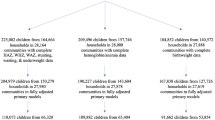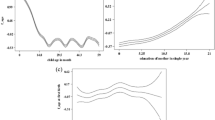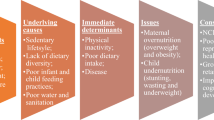Abstract
In the twenty-first century, when the world is experiencing significant scientific advancements, technological advancements, and medical advancements, millions of children continue to suffer from malnutrition, which poses a profound challenge to human civilization. Developing and underdeveloped countries, including India, are among those affected by this issue. India is actively addressing this problem, and there has been a reduction in the prevalence of child malnutrition over time. However, there is still a long way to go in fully addressing this issue. Numerous studies have been conducted to identify the possible causes and impacts of various factors on child malnutrition. Nevertheless, it is crucial to conduct longitudinal studies to understand the evolving effects of these factors on malnutrition. This study specifically focuses on the status of child malnutrition and its associated factors over time, particularly emphasising the absence of toilet facilities. The analysis is based on data from the 4th and 5th National Family Health Survey (NFHS) rounds. Descriptive statistics, bivariate scatter plots, bivariate LISA, and Morn's I index were employed to analyse the empirical results. The study's findings reveal that the absence of toilet facilities negatively impacts child health and positively correlates with malnutrition. While there has been some improvement, as the latest NFHS report indicates, the desired goal has not yet been achieved. Another contributing factor to the increased prevalence of malnutrition among children under the age of five is diarrhea, which is associated with the absence of toilet facilities. Additionally, the mother's education consistently emerges as a significant factor across all survey years, playing a role in reducing malnutrition. Based on these findings, it is crucial to implement decentralized policies with central-state cooperation, increase the budget allocation for child and maternal healthcare, and prioritize the improvement of sanitation facilities.













Similar content being viewed by others
Data availability
Not applicable.
References
Abuya, B. A., Ciera, J., & Kimani-Murage, E. (2012). Effect of mother’s education on child’s nutritional status in the slums of Nairobi. BMC Pediatrics, 12(1), 1–10.
Ahmad, S., Shukla, N. K., Singh, J. V., Shukla, R., & Shukla, M. (2018). Double burden of malnutrition among school-going adolescent girls in North India: A cross-sectional study. Journal of Family Medicine and Primary Care, 7(6), 1417.
Awasthi, S., Verma, T., Sanghvi, T., & Frongillo, E. A. (2019). Path to severe acute malnutrition in children below 2 years of age: Findings of qualitative research in Uttar Pradesh, North India. Clinical Epidemiology and Global Health, 7(2), 246–252.
Bhadoria, A. S., Kapil, U., Bansal, R., Pandey, R. M., Pant, B., & Mohan, A. (2017). Prevalence of severe acute malnutrition and associated socio-demographic factors among children aged 6 months–5 years in rural population of Northern India: A population-based survey. Journal of Family Medicine and Primary Care, 6(2), 380.
Black, R. E., Victora, C. G., Walker, S. P., Bhutta, Z. A., Christian, P., De Onis, M., ... & Uauy, R. (2013). Maternal and child undernutrition and overweight in low-income and middle-income countries. The Lancet, 382(9890), 427–451. https://doi.org/10.1016/S0140-6736(13)60937-X
Brown, K. H. (2003). Diarrhea and malnutrition. The Journal of Nutrition, 133(1), 328S-332S.
Carroll-Scott, A., Gilstad-Hayden, K., Rosenthal, L., Peters, S. M., McCaslin, C., Joyce, R., & Ickovics, J. R. (2013). Disentangling neighborhood contextual associations with child body mass index, diet, and physical activity: The role of built, socioeconomic, and social environments. Social Science & Medicine, 95, 106–114.
Chandra, R. K., & Kumari, S. (1994). Nutrition and immunity: an overview. The Journal of Nutrition, 124(suppl_8), 1433S-1435S.
Checkley, W., Gilman, R. H., Black, R. E., Epstein, L. D., Cabrera, L., Sterling, C. R., & Moulton, L. H. (2004). Effect of water and sanitation on childhood health in a poor Peruvian peri-urban community. The Lancet, 363(9403), 112–118.
Esrey, S. A., Habicht, J. P., & Casella, G. (1992). The complementary effect of latrines and increased water usage on the growth of infants in rural Lesotho. American Journal of Epidemiology, 135(6), 659–666.
Fanzo, J. (2015). Ethical issues for human nutrition in the context of global food security and sustainable development. Global Food Security, 7, 15–23.
Farid, K., Zhang, Y., Bachelier, D., Gilson, P., Teixeira, A., Safar, M. E., & Blacher, J. (2013). Cognitive impairment and malnutrition, predictors of all-cause mortality in hospitalized elderly subjects with cardiovascular disease. Archives of Cardiovascular Diseases, 106(4), 188–195.
Fink, G., Günther, I., & Hill, K. (2011). The effect of water and sanitation on child health: Evidence from the demographic and health surveys 1986–2007. International Journal of Epidemiology, 40(5), 1196–1204.
Galler, J. R., Bryce, C., Waber, D. P., Zichlin, M. L., Fitzmaurice, G. M., & Eaglesfield, D. (2012). Socioeconomic outcomes in adults malnourished in the first year of life: A 40-year study. Pediatrics, 130(1), e1–e7.
Gracey, M. (1996). Diarrhea and malnutrition: A challenge for pediatricians. Journal of Pediatric Gastroenterology and Nutrition, 22(1), 6–16.
Grantham-McGregor, S., Cheung, Y. B., Cueto, S., Glewwe, P., Richter, L., & Strupp, B. (2007). Developmental potential in the first 5 years for children in developing countries. The Lancet, 369(9555), 60–70. https://doi.org/10.1016/S0140-6736(07)60032-4
Hammer, J., & Spears, D. (2016). Village sanitation and child health: Effects and external validity in a randomized field experiment in rural India. Journal of Health Economics, 48, 135–148.
Hasan, M. T., SoaresMagalhaes, R. J., Williams, G. M., & Mamun, A. A. (2016). The role of maternal education in the 15-year trajectory of malnutrition in children under 5 years of age in B angladesh. Maternal & Child Nutrition, 12(4), 929–939.
Hoddinott, J., Maluccio, J. A., Behrman, J. R., Flores, R., & Martorell, R. (2008). Effect of a nutrition intervention during early childhood on economic productivity in Guatemalan adults. The Lancet, 371(9610), 411–416.
Iftikhar, A., Bari, A., Bano, I., & Masood, Q. (2017). Impact of maternal education, employment and family size on nutritional status of children. Pakistan Journal of Medical Sciences, 33(6), 1401.
International Institute for Population Sciences (IIPS) and ICF. (2021). National Family Health Survey (NFHS-5), 2019–21: India. IIPS, 373–442.
Irena, A. H., Mwambazi, M., & Mulenga, V. (2011). Diarrhea is a major killer of children with severe acute malnutrition admitted to inpatient set-up in Lusaka, Zambia. Nutrition Journal, 10(1), 1–6.
Jain, A., Shah, D., Das, S., Saha, R., & Gupta, P. (2020). Aetiology and outcome of acute diarrhoea in children with severe acute malnutrition: A comparative study. Public Health Nutrition, 23(9), 1563–1568.
Khan, J., & Mohanty, S. K. (2018). Spatial heterogeneity and correlates of child malnutrition in districts of India. BMC Public Health, 18(1), 1–13.
Lawal, S. A., Okunlola, D. A., Adegboye, O. A., & Adedeji, I. A. (2023). Mother's education and nutritional status as correlates of child stunting, wasting, underweight, and overweight in Nigeria: Evidence from 2018 Demographic and Health Survey. Nutrition and Health, 02601060221146320.
Lin, A., Arnold, B. F., Afreen, S., Goto, R., Huda, T. M. N., Haque, R., ... & Luby, S. P. (2013). Household environmental conditions are associated with enteropathy and impaired growth in rural Bangladesh. The American Journal of Tropical Medicine and Hygiene, 89(1), 130.
Mahmud, I., & Mbuya, N. (2015). Water, sanitation, hygiene, and nutrition in Bangladesh: Can building toilets affect children’s growth? The World Bank.
Makoka, D., & Masibo, P. K. (2015). Is there a threshold level of maternal education sufficient to reduce child undernutrition? Evidence from Malawi, Tanzania and Zimbabwe. BMC Pediatrics, 15(1), 1–10.
Nel, E. D. (2010). Diarrhoea and malnutrition. South African Journal of Clinical Nutrition, 23(sup1), 15–18.
NITI Aayog. (2017). Nouuishing India. National nutrition Strategy, Government of India. http://niti.gov.in/writereaddata/files/document_publication/Nutrition_Strategy_Booklet.pdf
Nordin, S. M., Boyle, M., & Kemmer, T. M. (2013). Position of the academy of nutrition and dietetics: Nutrition security in developing nations: sustainable food, water, and health. Journal of the Academy of Nutrition and Dietetics, 113(4), 581–595.
O’Dea, J. A., & Wilson, R. (2006). Socio-cognitive and nutritional factors associated with body mass index in children and adolescents: Possibilities for childhood obesity prevention. Health Education Research, 21(6), 796–805.
Patel, M. P., Sandige, H. L., Ndekha, M. J., Briend, A., Ashorn, P., & Manary, M. J. (2005). Supplemental feeding with ready-to-use therapeutic food in Malawian children at risk of malnutrition. Journal of Health, Population and Nutrition, 23(4), 351–357.
Patwari, A. K. (1999). Diarrhoea and malnutrition interaction. Indian Journal of Pediatrics, 66(1 Suppl), S124–S134.
Patwari, A. K. (2013). Millennium development goals and child undernutrition. Indian Pediatrics, 50(5), 449–452.
Paul, P., & Saha, R. (2022). Is maternal autonomy associated with child nutritional status? Evidence from a cross-sectional study in India. PLoS ONE, 17(5), e0268126.
Prasetyo, Y. B., Permatasari, P., & Susanti, H. D. (2023). The effect of mothers’ nutritional education and knowledge on children’s nutritional status: A systematic review. International Journal of Child Care and Education Policy, 17(1), 11.
Rah, J. H., Cronin, A. A., Badgaiyan, B., Aguayo, V. M., Coates, S., & Ahmed, S. (2015). Household sanitation and personal hygiene practices are associated with child stunting in rural India: A cross-sectional analysis of surveys. British Medical Journal Open, 5(2), e005180.
Rahman, M. H. U., Malik, M. A., Chauhan, S., Patel, R., Singh, A., & Mittal, A. (2020). Examining the linkage between open defecation and child malnutrition in India. Children and Youth Services Review, 117, 105345.
Rodríguez, L., Cervantes, E., & Ortiz, R. (2011). Malnutrition and gastrointestinal and respiratory infections in children: A public health problem. International Journal of Environmental Research and Public Health, 8(4), 1174–1205.
Singh, P., Shah, M., & Bruckner, T. A. (2021). Child undernutrition following the introduction of a large-scale toilet construction campaign in India. The Journal of Nutrition, 151(8), 2455–2464.
Smith, L. C., & Haddad, L. (2015). Reducing child undernutrition: Past drivers and priorities for the post-MDG era. World Development, 68, 180–204.
Spears, D., Ghosh, A., & Cumming, O. (2013). Open defecation and childhood stunting in India: an ecological analysis of new data from 112 districts. PloS one, 8(9), e73784.
Srinivasan, K. (2016). Malnutrition and mortality among children in India: need to revisit ICDS programme. Artha Vijnana: Journal of the Gokhale Institute of Politics and Economics, 58(4), 287.
Stein, A. D. (2018). Long-term effects of nutritional supplementation in childhood. The Journal of Nutrition, 148(1), 3–4.
Tappenden, K. A., Quatrara, B., Parkhurst, M. L., Malone, A. M., Fanjiang, G., & Ziegler, T. R. (2013). Critical role of nutrition in improving quality of care: An interdisciplinary call to action to address adult hospital malnutrition. Journal of the Academy of Nutrition and Dietetics, 113(9), 1219–1237.
UNICEF, WHO, & WB.(2012). UNICEFWHO-World bank joint child malnutrition estimates. New York, Geneva, Washington, DC.
UNICEF. (2015). Without toilets, childhood is even riskier due to malnutrition. New York.
UNICEF. Division of Communication. (2009). Tracking progress on child and maternal nutrition: a survival and development priority. Unicef.
Van den Bold, M., Quisumbing, A. R., & Gillespie, S. (2013). Women's empowerment and nutrition: an evidence review. International Food Policy Research Institute, 1–61.
Verma, M., Hontecillas, R., Abedi, V., Leber, A., Tubau-Juni, N., Philipson, C., ... & Bassaganya-Riera, J. (2016). Modeling-enabled systems nutritional immunology. Frontiers in Nutrition, 3, 5.
Victora, C. G., Adair, L., Fall, C., Hallal, P. C., Martorell, R., Richter, L., & Sachdev, H. S. (2008). Maternal and child undernutrition: Consequences for adult health and human capital. The Lancet, 371(9609), 340–357. https://doi.org/10.1016/S0140-6736(07)61692-4
Victora, C. G., Vaughan, J. P., Kirkwood, B. R., Martines, J. C., & Barcelos, L. B. (1986). Risk factors for malnutrition in Brazilian children: The role of social and environmental variables. Bulletin of the World Health Organization, 64(2), 299.
Walker, S. P., Wachs, T. D., Gardner, J. M., Lozoff, B., Wasserman, G. A., Pollitt, E., & International Child Development Steering Group. (2007). Child development: Tisk factors for adverse outcomes in developing countries. The Lancet, 369(9556), 145–157.
Wasihun, A. G., Dejene, T. A., Teferi, M., Marugán, J., Negash, L., Yemane, D., & McGuigan, K. G. (2018). Risk factors for diarrhoea and malnutrition among children under the age of 5 years in the Tigray region of Northern Ethiopia. PLoS ONE, 13(11), e0207743.
WHO, & UNICEF. (2015). Progress on sanitation and drinking water: 2015 update and MDG assessment. WHO/UNICEF Joint Water Supply, & Sanitation Monitoring Programme, World Health Organization.
Funding
No funding has been received for this research.
Author information
Authors and Affiliations
Contributions
The paper was conceptualized by Hussain and Biswas. Database computation and graphical presentation were carried out by Hussain, while the manuscript was written by Hussain and Biswas. The final revision and editing of the manuscript was done by Biswas.
Corresponding author
Ethics declarations
Competing interests
The authors declare no competing interest.
Additional information
Publisher's Note
Springer Nature remains neutral with regard to jurisdictional claims in published maps and institutional affiliations.
Rights and permissions
Springer Nature or its licensor (e.g. a society or other partner) holds exclusive rights to this article under a publishing agreement with the author(s) or other rightsholder(s); author self-archiving of the accepted manuscript version of this article is solely governed by the terms of such publishing agreement and applicable law.
About this article
Cite this article
Hussain, D., Biswas, B. Understanding the impact of socio-economic factors on child malnutrition in India with an emphasis on no-toilet facilities: Evidence from national family health surveys. GeoJournal 89, 16 (2024). https://doi.org/10.1007/s10708-024-11028-3
Accepted:
Published:
DOI: https://doi.org/10.1007/s10708-024-11028-3




